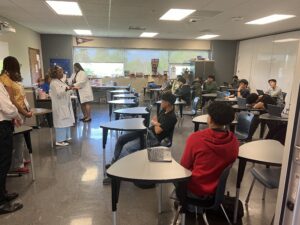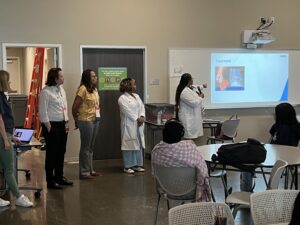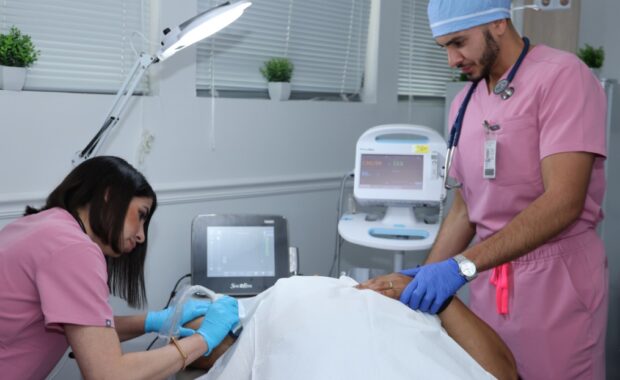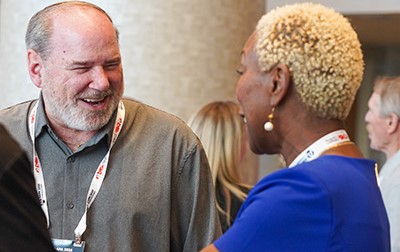Opening Doors, One Classroom at a Time
Project Access volunteers introduce the profession to young students
July 11, 2024
By Dorsey Griffith

When PAs asked the ninth-grade biology classes at Houston’s South Early College High School if they knew what a PA was, only a few hands went up.
By the end of the May 20 visit, the Project Access volunteers in Houston for AAPA 2024 had shared valuable information about the profession and personal success stories—and planted seeds of possibility.
Reflecting on the impact the PA profession has had on her life, Andre’lyn Williams, DMSc, MPAS, PA-C, who works at the Michael E. DeBakey VA Medical Center in the surgical ICU with the cardiothoracic critical care team, said becoming a PA “changed the trajectory of my [life and that of my] immediate family.” She inspired the students by saying, “‘If I can do it, you can do it. You have to believe in yourself.’”
Supported by AAPA and PAEA, Project Access is a longstanding program that sends PAs and PA students to middle and high schools to talk to historically marginalized students. The goal is to introduce the PA profession and enable students to ask questions about why the PA profession is a strong career choice. Often organized by statewide PA organizations, Project Access efforts take place at schools across the country.
“We try to target schools whose students come from underserved populations and are less likely to go into healthcare or do not know the pathway to get into healthcare professions,” said Kimberly Sapre, DMSc, PA-C, CAQ-EM, DFAAPA, chair of AAPA’s Commission on Diversity, Equity and Inclusion (DEI Commission). “The idea is to reach these students early, explain to them about the career, and show them they can do something like this.”
For the Houston effort, AAPA’s DEI Commission selected South Early College High School, where 98% of the enrollment is minority, and 76% of students are economically disadvantaged.
“We try to cater to those schools where students are already geared to college prep or have some science background,” said Dr. Williams, who organized the May event for AAPA. “Some of these students were already taking classes at the nearby Houston Community College, and this is their first step.”
Also, during AAPA 2024, representatives of the African Heritage PA Caucus held a Project Access event for 150 8th graders at Houston’s McReynolds Middle School, where 98% of students are considered “economically disadvantaged.”

Volunteers typically explain to students the differences between PAs and other healthcare professions, describe the PA educational requirements and cost of a PA education, the kinds of high school or college coursework and jobs that can benefit a PA school applicant, as well as the types of roles a PA can play in the healthcare workforce.
For PAs interested in hosting an event, a toolkit and presenter resources are available in AAPA’s Diversity, Equity, and Inclusion Resource Center.
Project Access volunteers understand the difficulties that young people encounter as they pursue higher education or enter the workforce. They also understand the need for a more diverse healthcare workforce, including in the PA profession.
“Our patients are diverse,” said Olushola Ilogho, MPA, PA-C, Vice President of the Virginia Association of Minority of PAs, who spoke to the students about the PA profession, including the profession’s history and the fact that the first female PA was an African American. “Patients will benefit from a more diverse PA profession,” she said. “Research has shown, especially in obstetrics, that having diverse providers makes a difference in patient outcomes.”
Recruiting minority candidates into the PA profession has been challenging. In 2023, the PAEA reported that just under 1% of PA students were American Indian or Alaskan native, 13.6% were Asian, 4.9% were Black, 0.3% were Native Hawaiian or Pacific Islander and over 80% were white.
However, this problem is not unique to the PA profession. Across the healthcare industry diversity is lacking. In 2020, the National Library of Medicine published data reporting that the U.S. healthcare workforce was comprised of more than 50% white, approximately 20% Asian, 7% Black, and less than 1% Hispanic and Native American workers. Through efforts like Project Access, PAs are committed to inspiring a future PA workforce that is diverse and representative of the patients PAs serve. Research consistently demonstrates the benefits of a diverse healthcare workforce.
In “In the Nation’s Compelling Interest,” a report by the National Institute of Medicine, researchers found that greater diversity among health professionals is associated with improved access to care for racial and ethnic minority patients, greater patient choice and satisfaction, better patient-provider communication and better educational experiences for all students while in training.
Cooper Couch, MPAF, PA-C provides full-spectrum primary care at an FQHC in Washington State. They entered the profession to help increase access to healthcare, which their family lacked while growing up in rural Oklahoma. Both of their parents died from chronic diseases that might have been prevented through better healthcare and health literacy.
 “I saw a girl paying no attention at first, but when I talked about my parents, her eyes lit up, and she was intently focused on me throughout the rest of the presentation,” Couch said. “In that moment, the student identified with the person speaking to them. That’s what we need to happen.”
“I saw a girl paying no attention at first, but when I talked about my parents, her eyes lit up, and she was intently focused on me throughout the rest of the presentation,” Couch said. “In that moment, the student identified with the person speaking to them. That’s what we need to happen.”
Tiffany Jordan, Assistant Director, AAPA National Health Priorities, said such encounters with students can be profound and influential. When a student approached her and asked if PAs can work in mental health, she confirmed and explained that many PAs work in psychiatry and that being a PA is an excellent path if they’re interested in that field. The student smiled as if she saw a whole new career path open up for her.
“I am continuously impressed with the impact PAs have on students and commend the African Heritage PA Caucus and DEI Commission for their service in Houston,” said Dr. Jennifer Orozco, AAPA’s Chief Medical Officer. “As we enter a new school year, we hope more PAs and PA organizations around the country take part in this innovative and important effort to encourage young people to pursue PA careers.”
AAPA is among many PA organizations that organize Project Access events, including several constituent organizations. In addition, PAEA hosts an annual competition during PA Week to determine which program hosts the most innovative Project Access events.
“The beauty is that any PA can do a Project Access event at any time,” said Dr. Sapre. “We try to set them up as much as we can.”
By the end of the high school sessions, the PA team had imparted understanding about and interest in a profession the students had previously known little or nothing about. “They were so excited, so engaged,” she said. “We changed their perception of the PA profession, and now they can say, ‘I could consider this,’” she said. “This tells me that projects like this can lead to more diversity within the profession.”
You May Also Like
About Project Access
AAPA’s Diversity, Equity, and Inclusion Resource Center
Until Next Year: AAPA 2024 Highlights
Thank you for reading AAPA’s News Central
You have 2 articles left this month. Create a free account to read more stories, or become a member for more access to exclusive benefits! Already have an account? Log in.



